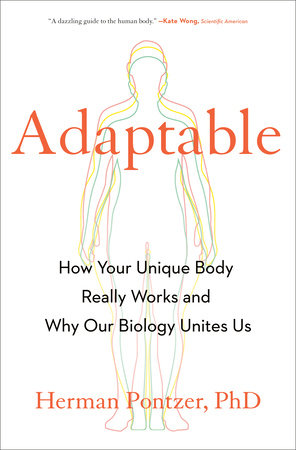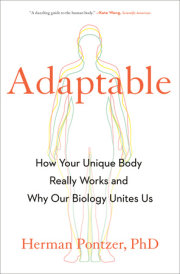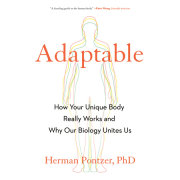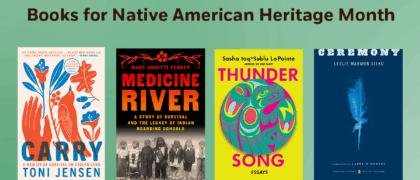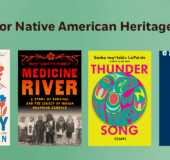1So Simple a BeginningHow old are you?
If you're reading this book the answer probably comes easily. Your birthday was one of the first dates you ever committed to memory, the promise of presents and cake cementing the coordinates into your internal calendar. As an adult that day might be less meaningful, or even cause for despair. But you know it. You know
exactly how old you are.
It might surprise you, then, that many people around the world today don't have a precise idea of their age. Much of my research takes me to communities like these, that don't keep calendars or track time the way we do in the industrialized world. It was a bit of a shock the first time I encountered it.
I was living and working with the Hadza community in the dry, wide-open savanna of northern Tanzania. It's a small and tight-knit population. Only about 1,200 people consider themselves Hadza and speak the language. The Hadza are hunter-gatherers, living in small grass houses clustered in camps among the acacia and baobab trees, making their living off of the wild landscape around them. Every morning, women leave camp in groups, on foot, to forage for berries or wild tubers. Men head out, usually alone, to hunt for antelope, giraffe, and other wild game using bows and arrows they make themselves. In a world that has rapidly moved to farms, then towns, and then to industrialized cities, the Hadza have maintained their traditional way of life for generations, perhaps millennia. There are no domesticated crops or animals in a Hadza camp, no electricity or plumbing, no guns or cars. And no calendars.
Settling into camp life on my first trip there, I would see kids running around, hanging out with mom and dad, sharing a meal around the fire. Trying to make a bit of friendly conversation, with the best Swahili (our common language) that I could manage, I'd ask a mom or dad how old their son or daughter was. The usual answer was a shrug.
Who doesn't know how old their kids are? I would wonder. Then I encountered it again when we interviewed the adults and asked their age.
No one knew. Our research team spent days each season working to figure out everyone's age.
It's a common theme in fieldwork with nonindustrial communities. I've encountered the same issue working with traditional pastoralists in northern Kenya, and my collaborators have had similar experiences all over the world. Accurate calendars that track our planet's orbit around the sun are a relatively recent invention of farming cultures that needed to know precisely when to plant their crops and when to harvest and prepare for winter. Lunar calendars are more common, and potentially more meaningful. Their cycle seems more in tune to the rhythms of daily life and our attention spans, and they determine how light the nights are in cultures without electricity. We've even kept them embedded in our Western calendars, though we've stretched them into months.
It's easy to be a bit smug about the tools we have to track time, as though by measuring it accurately we might exert some control. But do you
really know how old you are, even with your calendar? You know when you were born, of course, but what about all the stuff that happened before that? The day you were born, your body had already been under construction for months. In some ways, it's been under construction for more than a billion years.
Endless Forms Most BeautifulWatching the body develop is a bit like taking a walking tour of the history of life. You watch a single cell become a multicellular cluster, then fold itself into a simple tube with a gut and basic nervous system, grow a head with eyes and a mouth, and sprout limbs. We see vestiges of ancient structures as the embryo develops, hints of old designs that were once the norm but have since been abandoned or changed beyond recognition. A yolk sac forms in the first few weeks only to dissolve away. The jaw, ears, and throat grow from fleshy arches that would have become the gills of our fishy ancestors.
There's an old-fashioned idea that we pass through each stage of evolution as we develop. "Ontogeny recapitulates phylogeny" is how I learned it. That's not quite right-you don't pass through a fish stage, or a reptile stage. But the layered nature of evolution, each generation tweaking and adding to what came before, is obvious from our embryos.
About nine months before birth, somewhere near the outer reaches of one of mom's fallopian tubes, a sperm breaks through the wall of a recently ovulated egg, fertilizing it. (If you're not clear on how we get to this step, you might check out chapter 7 or schedule an awkward talk with your parents.) DNA carried by the sperm and egg, packaged in tightly wrapped chromosomes like skeins of yarn, will combine to become the embryo's genome, unique among all life, with the recipe for a human written in a four-letter code some 3 billion units long. After some gymnastics to package the twenty-three chromosomes from the sperm and the twenty-three from the egg into a single forty-six chromosome nucleus, it's time to grow.
That one cell divides into two, which each divide to make four, then eight, sixteen, thirty-two . . . all the while floating lazily along the fallopian tube, toward the uterus. At around sixty cells big, the cluster of cells fills with fluid, like a new soccer ball that somehow learned to inflate itself. Around five days after fertilization this fluid-filled ball of cells lands upon the uterus wall and burrows in, implanting. The cells embedded in the wall of the uterus will grow into the placenta, nestling up against the blood-rich walls of the uterus to pull in oxygen and nutrients. Only a tiny clump of cells on the inner wall will grow into the body.
At about three weeks after fertilization, that clump of cells grows and organizes itself into three distinct layers (picture a stack of three slices of bread). This three-layer sandwich curls to form a roll, and the layers form concentric tubes. The bottom layer becomes the innermost tube, the top layer becomes the outer tube, and the middle layer rests between them. That inner tube will become your digestive tract, from mouth to butt. And that's the basic body plan for fish, birds, reptiles, and mammals like us. We are all just elaborate tubes.
At the same time your main body tube is forming, a second tube forms down the middle of the outer layer. A deep groove develops along the surface, marking the track that will become your spine. The sides of the groove rise and crash into one another like cresting waves. They fuse together where they meet, converting the open gully into a closed "neural tube." As the name suggests, the brain and spinal cord will fill the neural tube eventually. Production of neurons, the cells that store and transmit information, begins in the sixth week after fertilization and continues throughout gestation.
The rest of the outer layer will develop into skin and hair as well as the skull. The middle layer will develop into the muscles, heart, and blood vessels, most of the skeleton, kidneys, and reproductive organs. The stomach, intestines, liver, and bladder all form from the innermost layer, along with the lungs. Timelines for organ development vary. Some get started in the fourth week after fertilization, and many continue to develop through gestation and into childhood. By ten weeks of development, things are far enough along that we switch from calling the growing organism an "embryo" to calling it a "fetus."
The origami of early development is tricky, and there is little tolerance for error-so little, in fact, that all animals use a nearly identical set of patterning genes to get started. That's why an early chicken embryo is hard to distinguish from that of a human. It took untold eons for these genes to evolve, but once in place they became so fundamental to development that they've barely changed for half a billion years. Every once in a while, a mutation in one of these early patterning genes turns out to be beneficial, leading to the evolution of new forms. But much, much more often, tweaking these early patterning genes ends in disaster for the developing embryo.
Other dangers lurk as well. An organ or a limb might not form properly. Hormonal signaling with the mother might break down, causing the embryo to be spontaneously aborted. If the neural tube doesn't close all the way, the baby will be born with a hole through its back or neck that, depending on the location, exposes the spinal cord or brain. Modern medicine has made important strides in reducing the risks of some of these problems. For example, we know now that taking folic acid (folate) supplements before and during pregnancy reduces the risk of neural tube defects like spina bifida. But even for healthy mothers in countries with top-notch health care, the rate of loss is remarkably high. Roughly 30 percent of embryos are spontaneously aborted, and about half of those are lost very early, before a woman is aware she's pregnant. You're lucky to be alive.
When Do We Start?So when, exactly, does a life begin in the midst of all this folding and dividing? As we'll see throughout this book, the way we understand our bodies informs the way we understand our world, and there may be no greater concern than life's origins. Even if we want to remove ourselves from the heated, personal arguments surrounding abortion, it seems we ought to have some clear idea of when life starts. It's the ultimate existential question. The answer is not at all obvious.
From a strictly biological perspective all cells are equally alive (unless they're dead), chugging along, carrying out their daily metabolic processes. One of those processes is cell division, one cell splitting into two, the fundamental process of reproduction. Your life is the continuation of an unbroken chain of living and dividing cells that began billions of years ago. You could claim any point in the history of life as your personal origin. From that perspective, there's no clear point where
you begin.
We can say life starts at fertilization, but that's still arbitrary. Eggs are roughly twenty thousand times larger by volume than sperm cells, which means we're more than 99.99 percent egg at the moment of conception. Adding a sperm to an egg doesn't reset its age any more than hanging a new air freshener from the rearview mirror of my 2004 Honda Civic makes it a new car. The egg from which you developed was produced while your mother was still an embryo, just nine weeks into development. It was already very much alive and probably decades old by the time it was fertilized. Your single-celled embryo was equally old, at least all but 0.005 percent of it.
If we want to know when someone's life begins, a better question might be
When does a developing embryo or fetus become a person? Biology is less equipped to answer that one. There's no biological definition of personhood-we've crossed into the realm of law, philosophy, or religion. Still, our legalistic or philosophical definitions would presumably be based on some biological criteria. Is there a clear point at which we can draw a line, one that doesn't have fuzzy edges and strange implications? As a biologist, I'm not sure there is.
There's the "life begins at conception" view, that fertilized eggs and very early-stage embryos should be treated as people because, unlike sperm and unfertilized eggs, they have the ability to become a unique individual. This perspective solves the issue of old eggs, but it raises other questions. First, how do we classify "monozygotic," or identical, twins, in which two individuals develop from the same fertilized egg? Surely a single fertilized egg can't be two people, but then one of the twin's lives (or both of them, depending on your perspective) must have started when the early embryo divided, not at conception. Perhaps we could say that any early embryonic cell or cell cluster with the potential to develop into an individual is a person. That would solve one twin problem but raise another. How would we classify conjoined twins, in which a single embryo only partially divides-one person or two? And how would we classify chimeras, in which two separate early embryos fuse together, resulting in one human?
Considering an embryo a person also raises philosophical questions about the hundreds of millions of spontaneously aborted early embryos, and more pragmatic issues for fertility clinics that create and store embryos for in vitro fertilization (IVF). IVF creates several embryos in test tubes, only some of which are implanted to start a pregnancy. The others are frozen or discarded. Should that practice be outlawed? That question holds stark implications for people relying on IVF to start a family. A 2024 Alabama Supreme Court decision that argued a fertilized egg is a person shut down fertility clinics across the state.
The view that personhood starts with fertilization is also complicated by modern technological advances that have removed the need for fertilization. We have the technology now to convert nearly
any cell in our body into an embryonic cell with the capability to become a unique individual. It's not legal to do this with human cells, but that doesn't mean it won't be done. Would that embryonic cell qualify as a person, even though it's not the product of fertilization? What about the adult cell it came from? It's true that turning an adult cell into a developing embryo requires a lot of outside intervention, but the same is true for a fertilized cell in the womb. No embryo can develop entirely on its own.
Another common argument against the "life begins at conception" perspective is that a cell doesn't have a brain and nervous system. If we reserve the definition of a person to an entity that is able to perceive the world and have at least some limited sense of self, then a fertilized egg or early embryo is no more a person than a clump of liver cells would be. But brain-based definitions of personhood make people queasy, for understandable reasons. Newborn infants have limited awareness compared to adults. People with brain injuries, developmental problems, or dementia might have severely compromised cognition. If you're in a coma or under anesthesia, your conscious brain activity might effectively be zero. Do we limit or deny personhood in these cases? In some ways we do: parents exert a lot of control over their children's lives, and adults with severe cognitive disabilities often have limited autonomy. But we still recognize all of these individuals as people, deserving of dignity and essential human rights.
Copyright © 2025 by Herman Pontzer PhD. All rights reserved. No part of this excerpt may be reproduced or reprinted without permission in writing from the publisher.

